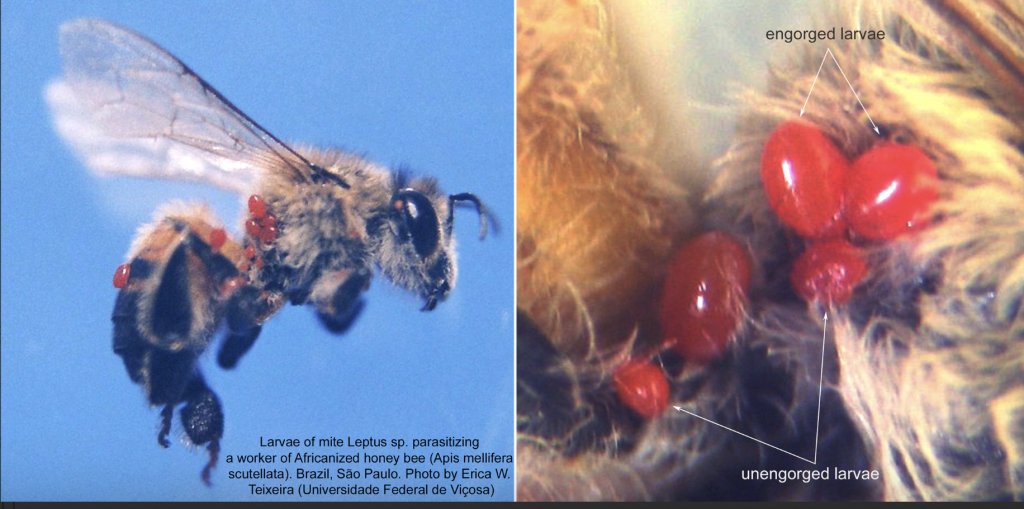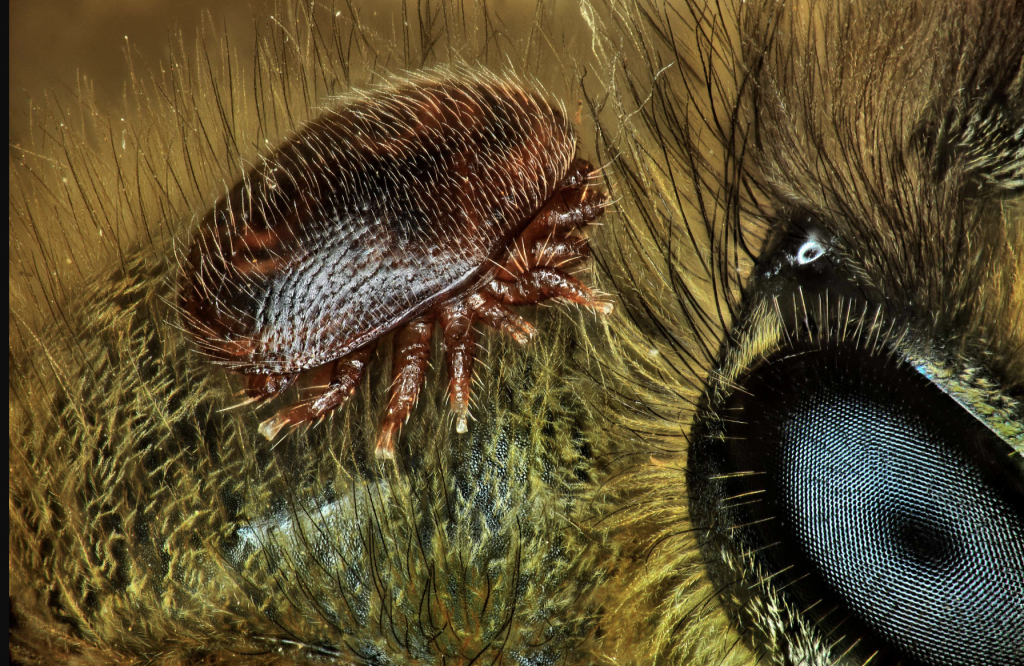
Alan Wade
The mighty mites
All this talk about honey bee mites and other honey bee pests taking an easy ride: ‘How and when were they discovered?’ And ‘how did they learn to hitch a ride?’ Can they be defeated?
Mites, all eight-legged, are typically midget spider and scorpion-like arachnids in a distinctive Acari sub class all of their own. The alphabet mite soup – about a million species (30,000 or so described) – rival the number of stars in the sky: their fossil record reaches back to the Early Cretaceous 410 million years ago.

Peter Fonda (Wyatt) and Dennis Hopper (Billy) in the classic 1969 film Easy Rider.
Out of this primordial mite soup emerged many invertebrate (a few honey bee), plant, crop and animal pests. The majority of hive mites are scavengers or raiders of pollen in stored bee comb.
Mites not the only pests taking a free ride
There are myriad other pests and diseases of honey bees and it is interesting to reflect on the arrival in Australia of some of the more important interlopers (Table 1). Importantly and missing to date in Australia are the giant honey bee ‘tropi’ mites, Tropilaelaps mercedesae and Tropilaelaps clareae, and the Asian hornets Vespa velutina and Vespa mandarinia.
| Pest or disease | Causative agent | Incursion date | Notes |
| American Foulbroodi | Paenibacillus larvae | Incursion date not known but likely spreading. | Differentiated from EFB in 1906. Absent from NT and Kangaroo Island (SA) |
| Sacbrood virus (SBV)ii | Sacbrood virus genotype AM (genotype AC less lethal) | 1913 (first characterised in US but widespread) | Separate genotypes for Apis mellifera and Apis cerana |
| Braula flyiii | Braula coeca | 1932 (Tas) | Detected in Vic 2023 |
| Cane toadiv | Rhinella marina | 1935 (Qld) | Now widespread in tropics |
| European or German waspv | Vespula germanica | 1959 (Tas) | Now widespread in SE Australia, southern South Australia and SW Western Australia. Common wasp Vespula vulgaris also in Vic |
| Nosemavi (Apis mellifera origin) | Nosema apis | 1961 (first isolated in SA) | Isolated in UK in 1955. Nosema cerana now widespread; Nosema neumanni now most common in Uganda. |
| Black queen cell virus (BQCV)vii | Black queen cell virus | 1974 (first characterised in UK) | Widely known to kill queen larvae in Australia in 1993 |
| European Foulbroodviii | Mellisococcus pluton | 1977 (NSW, Vic, SA) | Absent from WA and NT |
| Buff-tailed Bumblebeeix | Bombus terrorists | 1992 (Tas) | 1909 attempt to introduce bumble bees to Tas failed. |
| Chalkbroodx | Ascosphaera apis | 1993 (Qld) | Spread to all states by 2001 |
| Small hive beetlexi | Aethina tumida | 2002 (NSW) | Was absent from WA until a load of irradiated beehives with shb was moved to the Kimberly |
| Asian honey beexii | Apis cerana | 2007 (Qld) | Established near Cairns |
| Nosemaxiii (Apis cerana origin) | Nosema ceranae | 2009 | First isolated in Taiwan in 1996 |
| Israeli acute paralysis virus (IAPV)xiv | Israeli acute paralysis virus (IAPV) | 2017 (identified by Roberts et al) | |
| Lake Sinai virus (LSV1 and LSV2) | Lake Sinai virus | 2017 (identified by Roberts et al) | |
| Varroa mitexv | Varroa destructor | 22 June 2022 (NSW) | Detected at Port of Newcastle, NSW (previous incursions at Townsville 2016, 2019 and 2020) |
| Small red dwarf honey beexvi | Apis florea (Euvarroa sinhai) | 6 July 2023 (WA) | Burra Peninsula near Karratha WA |
| Varroa mitexvii | Varroa jacobsoni | 27 February 2024 | News report of PNG Varroa import |
Table 1 Arrival timetable of common honey bee pests and diseases in Australia.
Global identification of phoretic hitchhiker mites
Phoretic or hitchhiker mites are new to Australia although the seemingly innocuous Ascarapis dorsata and Ascarapis externus are known to be here on Apis melliferaxviiiand are common enough in southern Asia and likely elsewhere. Of course the June 2023 establishment of Varroa destructor, first detected at the Port of Newcastle and found well established nearby, has had all the headlines. But what of the discovery of mites in general?
The Leptus mite genus, common enough parasites of arthropodsxix, are the latest mites to be found making an easy meal of honey bees. Leptus ariel infest Africanised honey bees in Brazil and Guatemala but were only recognised around 1980.xx Leptus and many other mites parasitise a broad spectrum of arthropods, including several unidentified Leptus species that also attack bees.xxi

Figure 1 Leptus mites on Africanised honey bee in São Paulo, Brazil
Photos Erica W. Teixeiraxxii
First off the rank to be discovered, however, were the varroa mites of the Varroa jacobsoni–Varroa destructor group (Figure 2). They were first described by Oudemans in 1904 from mites found on the Asian honey bee Apis cerana.xxiii There are many Varroa destructor halotypes and likely yet more species including Varroa rindereri that parasitises Apis cerana and Varroa underwoodi that parasitises its close associate Apis koschevnikovi.xxiv
More widely known by the early 20th century was the tracheal mite Ascarapis woodi. It devastated European beekeepingxxv but the origins of widespread mites in the Ascarapis genus are unknown while the origins of the outbreaks, then widely attributed to Ascarapis woodi, has been recently attributed to other causes. The existence of two relatively innocuous external mites Ascarapis externus and Ascarapis dorsalis in Asian honey bees suggests a source of the genus lies in deeper time. The tracheal mite, Acarapis woodi, though recently reported as causing high colony mortality in Asian and American (western) honey beesxxvi, is no longer regarded as a threat

Figure 2 Adult Varroa destructor mite on Western Honey Bee.xxvii
There are other mites on the horizon, ones we have all read about being the tropi or Tropilaelaps mites. Mercedes Delfinado and Edward Bakerxxviii were the first to describe such mites. In the same study Tropilaelaps clareae mites (the type species) were found on field rats and honey bees at the Gangstas Apiaries at Mataasna-Kahoy, Lipa in the Luzon district in the Philippines. That was in 1961.
Originally confined to tropical giant honey bees, another tropi mite Tropilaelaps mecedesae, with its also newly acquired western honey bee host, is spreading elsewhere and into cold-temperate climes. The source of tropi mite re-emergence in regions where honey bees become broodless for extended periods has not been identified. However it seems likely that Tropilaelaps will likely naturally displace Varroa wherever colonies maintain at least some brood year round. While tropi mites breed faster, both mites are persisting in a dynamic equilibrium on Apis mellifera in more temperate climes.xxix
Significantly the Mercedes-Baker duo described a new family of honey bees mites, type species Euvarroa sinhai, on Apis florea from an apiary in New Delhi in 1971.xxx One can only trust that the likes of Leptus species and Tropilaelaps clareae, not just Tropilaelaps mercedesae, do not emerge to become even more serious pests of honey bees.
Readings
iNSW Department of Primary Industries (November 2020). American foulbrood identification and management. Primefact 209, Fourth edition. https://www.dpi.nsw.gov.au/__data/assets/pdf_file/0003/66216/American-foulbrood.pdf
Matheson, A. (1995). World bee health update. Bee World 76(1):31-39. doi.org/10.1080/0005772X.1995.11099235 refers
Hornitzky, M. (1990). Honey bee diseases in Australia 1990 – overview. The Australasian Beekeeper 92(1):20-28.
Matheson, A. and Reid, M. (1992). Strategies for prevention and control of American foulbrood. II. American Bee Journal 132(6):399–402, 471–475, 534–537, 547.
iiWikipedia (accessed 24 February 2024). Evolution of the sacbrood virus. https://en.wikipedia.org/wiki/Evolution_of_the_Sacbrood_Virus
iiiTasmanian Beekeeping Association (accessed 23 February 2024). The history of beekeeping in Tasmania. https://www.tasmanianbeekeepers.org.au/history/
Honan, K. ABC Rural (7 Sep 2022). NSW closes border to Victorian beehives following detection of braula fly in illegal hive movement. https://www.abc.net.au/news/rural/2022-09-07/nsw-stops-beehives-from-victoria-after-braula-fly-detection/101412374
ivStaff, A.G. (14 March 2023). Defining moments in Australian history: Introduction of cane toads. Australian Geographic. https://www.australiangeographic.com.au/topics/history-culture/2023/03/defining-moments-in-australian-history-introduction-of-cane-toads/
vSpradbery J.P. and Maywald G.F. (1992). The distribution of the European or German wasp, Vespula germanica (F.)(Hymenoptera: Vespidae), in Australia: past, present and future. Australian Journal of Zoology 40(5):495-510. https://www.publish.csiro.au/ZO/ZO9920495
viHornitzki, M. (March 2008). [NSW Department of Primary Industries]. Nosema disease: Literature review and three year survey of beekeepers Part 2 https://agrifutures.com.au/wp-content/uploads/publications/08-006.pdf
viiAllsopp, M., Benjeddou, M. Davison, S. and Leat, N. (2002). Journal of General Virology 83:3139-3146. Development of infectious transcripts and genome manipulation of Black queen-cell virus of honey bees. doi:10.1099/0022-1317-83-12-3139
Anderson, D.L. (1993). Pathogens and queen bees. The Australasian Beekeeper 94(7):292–296.
viiiNSW Department of Primary Industries (accessed 23 February 2024). European Foul Brood. https://www.dpi.nsw.gov.au/animals-and-livestock/bees/pests-diseases/european-foulbrood/european-foulbrood-control
ixField guide to the insects of Tasmania (accessed 27 February 2024). https://tasmanianinsectfieldguide.com/hexapoda/insectsoftasmaniahymenoptera2/superfamily-apoidea-s-l/apidae/bombus-terrestris-bumblebee/
xAronstein, K.A. and Murray, K.D. (2010). Chalkbrood disease in honey bees. Journal of Invertebrate Pathology 103:S20-S29. https://sci-hub.hkvisa.net/10.1016/j.jip.2009.06.018 https://www.sciencedirect.com/science/article/abs/pii/S002220110900189X
xiNeumann, P. and Elzen, P.J. (2004). The biology of the small hive beetle (Aethina tumida, Coleoptera: Nitidulidae): Gaps in our knowledge of an invasive species. Apidologie 35(3):229–247. doi:10.1051/apido:2004010
xiiOwen, R. (2022). Apis cerana genetics in Cairns. The Australasian Beekeeper 124(6):34-35.
xiiiGiersch, T., Berg, T., Galea, F. and Hornitzky, M. (2009). Nosema ceranae infects honey bees (Apis mellifera) and contaminates honey in Australia. Apidologie 40(2):117-123. doi:10.1051/apido/2008065
Fries, I., Martin, R., Meana, A., García-Palencia, P. and Higes, M., 2006. Natural infections of Nosema ceranae in European honey bees. Journal of Apicultural Research 45(4):230-233. pdf at Google Scholar.
xivRoberts, J.M.K., Anderson, D.L. and Durr, P.A. (2017). Absence of deformed wing virus and Varroa destructor in Australia provides unique perspectives on honeybee viral landscapes and colony losses. Scientific Reports 7(1):6925. doi:10.1038/s41598-017-07290-w
xvAustralian Government Department of Agriculture, Fisheries and Forestry (accessed 23 February 2024). Varroa mite (Varroa destructor). https://www.outbreak.gov.au/current-outbreaks/varroa-mite
xviWestern Australian Department if Primary Industries and Regional Development (6. July 2023). Report sightings of red dwarf honey bees. https://www.agric.wa.gov.au/news/media-releases/report-sightings-red-dwarf-honey-bees
xviiHughes, M. (28 February 2024). Biosecurity Queensland investigating detection of Varroa jacobsoni mite in the Port of Brisbane. ABC News. https://www.abc.net.au/news/2024-02-26/varroa-jacobsoni-mite-detected-in-port-of-brisbane/103512374?utm_source=abc_news_app&utm_medium=content_shared&utm_campaign=abc_news_app&utm_content=link
xviiiDelfinado-Baker, M. and Baker, E.W. (1982). Notes on honey bee mites of the genus Acarapis hirst (Acari: Tarsonemidae). International Journal of Acarology 8(4):211-226. doi:10.1080/01647958208683299
xixKlimov, P., O’Connor, B., Ochoa,R., Bauchan, G., Redford, A. and Scher, J. (October 2016). Leptus. USDA Bee Mite ID. https://idtools.org/bee_mite/index.cfm?packageID=1&entityID=115
xxMartin, S.J. and Correia-Oliveira, M.E. (2016). The occurrence of ecto-parasitic Leptus sp. mites on Africanized honey bees. Journal of Apicultural Research 55(3):243-246. doi:10.1080/00218839.2016.1228214 https://salford-repository.worktribe.com/preview/1493730/leptus20JAR20revised20submitted1.pdf
Flechtmann, C.H.W. (1980). Dois ácaros associados à abelha (Apis mellifera L.) no Perú [Two mites associated with the bee (Apis mellifera) in Peru]. Anais da Escola Superior de Agricultura Luiz de Queiroz 37(2):737–741. https://www.researchgate.net/publication/281320214_Dois_acaros_associados_a_abelha_melifera_Apis_mellifera_L_no_Peru
Southcott, R.V. (1989). A larval mite (Acarina: Erythraeidae) parasitizing the European honey bee in Guatemala. Acarologia 30(2):123-129. https://www.semanticscholar.org/paper/A-larval-mite-(Acarina%3A-Erythraeidae)-parasitizing-Southcott/3953661ef6c557cda25e3234d945334f189719fc?sort=relevance&page=2
Southcott, R.V. (1992). Revision of the larvae of Leptus latreille (Acarina: Erythraeidae) of Europe and North America, with descriptions of post-larval instars. Zoological Journal of the Linnean Society 105(1):1-153. doi.org/10.1111/j.1096-3642.1992.tb01228.x https://sci-hub.et-fine.com/10.1111/j.1096-3642.1992.tb01228.x
Quintero, M.M.T., Argote C,C. and Acevedo, H.A. (1987). Hallazgo de Pcaros del gtnero Leptus sp., parasitando a Apis mellifera. Veterinaria México 18(3):229-231.
Quintero, M.M.T., Argote C,C. and Acevedo, H.A. (1987). Mites of the genus Leptus sp parasitizing Apis mellifera short communication. Veterinaria México 18(3):229-231.
https://www.cabidigitallibrary.org/doi/full/10.5555/19910229872
Wilson, W.T., Wooley, T.A., Nunamaker, R.A. and Rubink, W.L. (1987). An erythraeid mite externally parasitic on honey bees (Apis mellifera). American Bee Journal 127(12):853-854.
Teixeira, É.W. (2008). Ocorrência de larvas de Leptus sp. Latreille 1796 (Acarina: Erythraeidae) em operárias de abelhas africanizadas A. mellifera Linnaeus 1758 (Hymenoptera: Apidae), no Brasil. Boletim de Indústria Animal 65(3):249-251. http://bia.iz.sp.gov.br/index.php/bia/article/view/1130 http://bia.iz.sp.gov.br/index.php/bia/article/view/1130/1124
xxiBee mite ID (Accessed 8 February 2024). Leptus. https://idtools.org/bee_mite/index.cfm?packageID=1&entityID=115
Southcott, R.V. (1999). Larvae of Leptus (Acarina: Erythraeidae), free-living or ectoparasitic on arachnids and lower insects of Australia and Papua New Guinea, with descriptions of reared post-larval instars. Zoological Journal of the Linnean Society 127(2):113–276. doi.org/10.1111/j.1096-3642.1999.tb00677.x https://academic.oup.com/zoolinnean/article/127/2/113/2684348?login=false
xxiiTeixeira, E.W. (accessed 1 March 2024). Leptus. Universidade Federal de Viçosa. https://idtools.org/bee_mite/index.cfm?packageID=1&entityID=115
xxiiiOudemans, A.C. (1904). Nog iets aangaande de Afbeeldingen met beschrijving van insecten, schadelijk voor naaldhout. Entomologische Berichten 18:156-164.
Oudemans, A.C. (1904). Note VIII. On a new genus and species of parasitic acari. Notes Leyden Museum 24:216–222.
Chemurot, M., De Smet, L., Brunain, M., De Rycke, R. and de Graaf, D.C. (2017). Nosema neumanni n. sp.(Microsporidia, Nosematidae), a new microsporidian parasite of honeybees, Apis mellifera in Uganda. European Journal of Protistology 61(Part A):13-19. doi:10.1016/j.ejop.2017.07.002 https://www.sciencedirect.com/science/article/pii/S0932473917301001
xxivAnderson, D.L. and Trueman, J.W.H. (2000). Varroa jacobsoni (Acari: Varroidae) is more than one species. Experimental and Applied Acarology 24(3):165–189. doi:10.1023/A:1006456720416
Carreck, N. and Neumann, P. (2010). Honey bee colony losses. Journal of Apicultural Research 49(1):1-6. doi:10.3896/IBRA.1.49.1.01
xxviiFranck, A. (2018). Varroa destructor (mite) on the back of Apis mellifera (honeybee). Nikon Small world 2018 photomicrography competition. https://www.nikonsmallworld.com/images/photos/2018/Varroa_destructor-Antoine_Franck-Cirad.jpg
xxviiiDelfinado, M.D. and Baker E.W. (1961). Tropilaelaps, a new genus of mite from the Philippines (Laelapidae [s. lat.], Acarina). Fieldiana Zoology 44(7):53–56. https://www.biodiversitylibrary.org/partpdf/36189
xxixChantawannakul, P., Ramsey, S., vanEngelsdorp, D., Khongphinitbunjong, K. and Phokasem, P. (2018). Tropilaelaps mite: An emerging threat to European honey bee. Current Opinion in Insect Science 26:69-75. doi:10.1016/j.cois.2018.01.012 https://www.sciencedirect.com/science/article/abs/pii/S2214574517300810
xxxDelfinado, M.D. and Baker, E.W. (1974). Varroidae, a new family of mites on honey bees (Mesostigmata: Acarina). Journal of the Washington Academy of Sciences 64(1):4-10. https://www.jstor.org/stable/24535743
